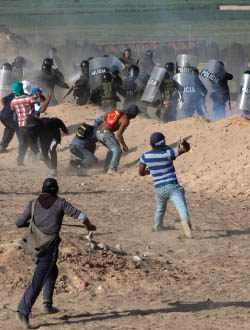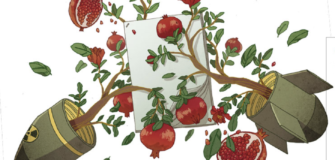Peru’s Racial Preoccupations

 Competing parties in the coming election show little concern about a structure that allows racism to prevail
Competing parties in the coming election show little concern about a structure that allows racism to prevail
Peru is not usually associated with racism. But when we see that 75 percent of the 69,280 victims of the political conflict during the 1980s and 1990s, as reported by the Peruvian Truth and Reconciliation Commission, were indigenous people of Quechua, Aymara or Amazonian origins, one may legitimately wonder.
The persistence and flourishing of racism in Peru are in fact a direct consequence of a national structure in which racist discourse and practices are perceived as normal and natural. If the theorist David Goldberg writes that the modern state is racial because it is “intimately involved in the reproduction of national identity, the national population, labour and security in and through the articulation of race, gender, and class[,]” then Peru is a racial state. Peruvian society and the Peruvian state and media participate in the manufacture of the nation following an ideal racial model: capitalist, urban, limeño (referring to Lima, the capital city), Western, Spanish-speaking and white. This model is acknowledged as ideal because it is believed to serve ‘progress.’
What is the Peruvian state’s understanding of ‘progress’? Answer: high scores on economic indicators in particular – GDP, trade balance, and central bank reserves – and on the Human Development Index (HDI) more generally. In the name of progress, Peruvians undergo coercive or consensual formation and transformation in order to become ideal citizens. Should they fail to do so, they are excluded, isolated, and even eliminated. In culturally diverse countries like Peru, this framework necessarily has racist implications.
The next general election will take place in April of next year. Opinion polls show that Keiko Fujimori, Pedro Kuczynski and Alan Garcia already enjoy the support of more than half of the Peruvian population. Racially tainted incidents have plagued these and other potential candidates with little national discussion or reflection. Keiko, the daughter of former president Alberto Fujimori (in office between 1990 and 2000, and convicted for human rights abuses) and leader of the centre-right Fuerza Popular (‘Popular Force’), currently leads the polls even though many questions remain unanswered in respect of the compulsory sterilization programme purportedly applied without women’s consent under her father’s regime. The victims of that programme were largely Quechua-speaking women from economically deprived rural areas.
Of course, the Fujimoris are a Peruvian family of Japanese origin. And yet not every racial or ethnic group in Peru is subject to the same social exclusion. Peruvians of Asian origin are, to be sure, the target of mockery and are generally excluded from advertisements related to aesthetic beauty. However, a 2007 study by psychologists in the Pontifical Catholic University of Peru (PUCP) found that Peruvians of Asian origin tended to be associated with politeness, honesty, trustworthiness, intelligence, competence and, more generally, success. By contrast, the levity with which the sterilization programme is today viewed by many Peruvians suggests a latent tolerance of human rights violations against indigenous people (or poor people) in the name of progress.
Kuczynski, the leader of the Peruanos Por El Kambio (Peruvians For Change) party, is an American-Peruvian dual citizen who supports free-trade agreements and mining interests. He is currently second in the polls. He has publicly stated that Andean people tend to flout rules and cheat on contracts, and opt for the nationalization of industries as a consequence of diminished cerebral oxygen counts in the highlands. The underlying message from Kuczynski is an abiding Peruvian skepticism about the value of the participation of andinos in political and economic decision-making.
Garcia, the leader of centre-left Alianza Popular Revolucionaria Americana (American Popular Revolutionary Alliance), is legitimated largely by the amnesia of his compatriots. Peruvians seem to have forgotten about the 2009 political crisis during Garcia’s second presidency (2006 to 2011), as well as his tumultuous first presidency (1985 to 1990). In June 2009, faced with protests by indigenous people from the Amazon rainforest in opposition to oil development, Garcia declared a state of emergency and sent in the military. The death toll was 23 police officers – plus one missing – and 10 indigenous people. Three months before the incident, Garcia had suggested publicly that Peru was a sad and backward country because, as an Andean nation “where indigenous people still grew coca plants[,]” Peruvians are marked by “low racial and genetic” capacity.
The current president, Ollanta Humala, has over the last year had to reckon with close to 600 social conflicts. These conflicts typically involve indigenous and farming communities. The most violent conflicts have taken place in the Peruvian Andes. Among these, the Tia Maria conflict has perhaps most prominently betrayed many of the racist undertones of Peruvian society. When the Mexican firm Southern Copper Corporation intended to start investing this year in the production of copper in the province of Islay, farming communities started a strike, claiming that copper production could damage an environment that was better suited to agriculture. When the violence escalated in March, President Humala declared a state of emergency in Islay.
After the presidential decision, the conflict became increasingly racialized in the media and public discourses. For example, El Comercio and Correo, two high-circulation Peruvian newspapers, excluded news related to Tia Maria from their ‘Economia’ sections and instead included such news in the ‘Regiones’ and ‘Nacional’ sections, respectively. Some of the most common terms used by Correo in its ‘Nacional’ section are variations of the Spanish words for ‘crime,’ ‘wounded,’ ‘death’ or ‘dengue fever.’ In this way, Tia Maria was no longer represented or seen as an economic issue, but rather as an issue mostly associated with anything happening en provincial – away from the capital city and urban areas – and also with crime and disease.
Images also matter. On one side in Tia Maria, we see agitated farmers, indigenous people, police and soldiers, surrounded by rocks, fire, blood, weapons, sticks, balaclavas and smoke. On the other side, we see calm and well-groomed individuals surrounded by microphones, chairs, tables, papers and glasses of water. The imagery makes clear that the first camp consists of the troublemakers, while the second has the peacemakers.
A few weeks after the end of the 2013 Bolivarian Games, the cover of the gossip magazine ¡Hola! Peru featured seven Peruvian gold-medal winners. Of course, Peru had won 61 gold medals in the Games. All of the seven winners on the cover were white (some blonde), attractive young people, holding court in what appeared to be an exclusive club. The first and last names of the seven were written in such a way that readers could not know which face belonged to which name. But there was, to be sure, a noticeable pattern among the names: more than half were not Spanish or native-Peruvian last names, and the remaining Spanish last names were uncommon in Peru. Instead, the last names Fiol, Cuglievan, Cuba, Winder, Tudela, McFarlane and Zimmermann were used to fit the narrative and key themes of the magazine – fashion, beauty, gourmet and design – rather than to celebrate Peru’s achievements in the Games.
Tia Maria, too, includes a set of last names and images that fit a particular narrative – although this time the narrative is crime, conflict and disease. Photographs of farmers, indigenous people, police and soldiers are labelled with Quechua, Aymara and very common Spanish last names: among others, Mamani, Quispe, Vilca, Herrera, Lopez, Apaza and Chura. These names are taken not from a list of medal winners, but from a roster of gunshot and lynching victims.
Even as racism pervades the Peruvian state and Peruvian society, there are laws on the books to combat it. State institutions like the Ministry of Culture actively engage in projects and campaign against racism. For example, the Alerta Contra el Racismo (Alert Against Racism) campaign disseminates academic and newspaper articles and runs a mobile phone application to report cases of racism. The media also play their part, occasionally exposing significant cases of racist discrimination in the exclusive clubs of Lima. Some members of civil society, too, have been energetic in the fight – for instance, in the campaign against racial segregation on Peruvian beaches.
There is still much to be done. Racism in Peru is a complex phenomenon. It needs to be addressed systematically and over the long run. The state should start by making the fight against racism a national policy that pervades all public and private institutions, and radiates to the whole of society. This should go hand in hand with the development of an educational system that is respectful of Peru’s cultural diversity – not bringing Lima to the Andes or the Andes to Lima, but making these and other spaces equally valuable, while respecting their cultural differences. This same educational system must begin to tell a better story about the definitions of ‘progress’ that would better serve all Peruvians in their great internal variety.
More bluntly still, perhaps the election of a new government in Lima – starting with next year’s – should begin to turn more on the ability of national leadership candidates to change the systemic dynamics that allow racism to persist and flourish in Peru. If the world boycotted South African products during apartheid, should it not be at least cognizant of a theatre where racist ideology is just as injurious, even if less explicit?
Luis Escobedo is Visiting Lecturer in the Department of International Relations and Humanities at the Monterrey Institute of Technology (ITESM), Campus Queretaro, Mexico.











